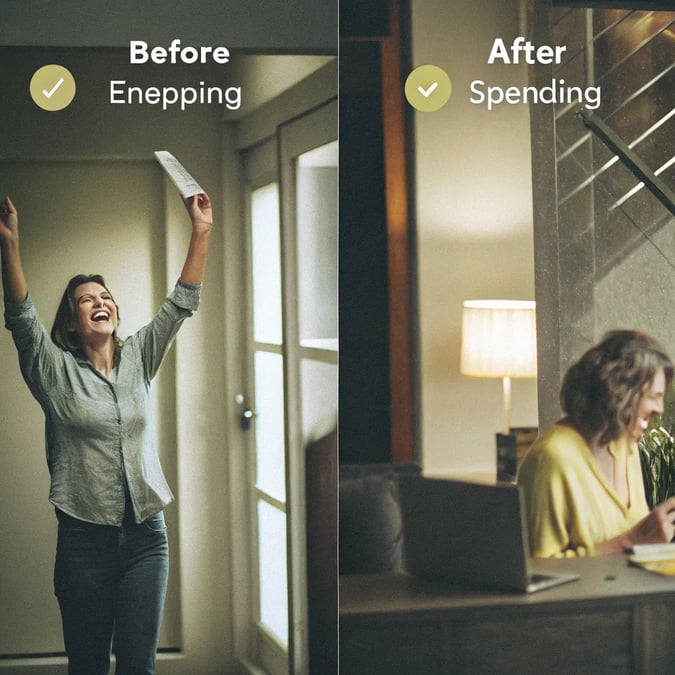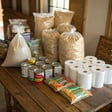
Budgeting has never been my strong suit. For years, I watched my bank account fluctuate wildly between paydays, always wondering where my money disappeared to. That was until I stumbled across the envelope system—a budgeting method so simple yet effective that it completely transformed my financial life.
What Is the Envelope System?
The envelope system is a cash-based budgeting method where you allocate specific amounts of money to different spending categories using physical envelopes. Once an envelope is empty, you stop spending in that category until the next budgeting period.
This method dates back generations, long before credit cards and banking apps existed. Our grandparents might not have called it the "envelope system," but many practiced this approach—keeping grocery money in the kitchen drawer or holiday savings in a special jar.
How the Traditional Envelope System Works

The traditional envelope system is refreshingly straightforward:
- Identify your spending categories (groceries, entertainment, gas, etc.)
- Determine how much to allocate to each category
- Cash your paycheck
- Divide the cash into labeled envelopes
- Only spend what's in each envelope
When I first heard about this system on a Dave Ramsey podcast, it sounded almost too simple. But sometimes the simplest solutions are the most powerful.
Why I Needed a Change
Last March, I reviewed my bank statement and nearly had a panic attack. Somehow, I'd spent over $600 at restaurants in a single month—more than my car payment! And I couldn't even remember most of those meals.
This wasn't an isolated incident. Every month brought new financial surprises:
- "Where did that $200 go?"
- "Did I really spend that much on coffee?"
- "How am I already overdrafted again?"
My digital banking app categorized my spending, but seeing the damage after it happened wasn't helping. I needed something more tangible—something that would make me think twice before swiping my card.
How I Implemented the Envelope System
After watching several YouTube videos (including one from a creator who claimed this method "changed her life"), I decided to give it a try. Here's how I adapted the system to work for me:
Step 1: I Tracked My Spending for One Month
Before creating envelopes, I needed to know where my money was actually going. For one painful month, I recorded every purchase—from my mortgage payment to the $2 vending machine snack.
This exercise was eye-opening. I discovered I was spending nearly $75 weekly on random Amazon purchases I barely remembered making.
Step 2: I Created My Categories
Based on my spending patterns, I created eight envelope categories:
- Groceries
- Gas
- Dining out
- Entertainment
- Personal care
- Household items
- Gifts
- Miscellaneous
I didn't include fixed expenses like rent, utilities, and insurance since these were already automated.
Step 3: I Set Realistic Limits
This was tricky. Initially, I wanted to slash my restaurant budget from $600 to $100, but I knew such a dramatic cut would lead to failure. Instead, I reduced it to $300—still a significant improvement but more sustainable.
For each category, I asked myself: "What's reasonable but still challenges me to be mindful?"
The Digital Adaptation
While I loved the concept, carrying cash everywhere felt impractical. What if I lost my envelope wallet? What about online purchases?
I created a hybrid approach that works beautifully:
- For daily variable expenses (groceries, dining, entertainment): I use cash envelopes
- For online shopping: I have a separate debit card linked to a spending account
- For fixed bills: I use automatic payments from my main checking account
Each payday, I withdraw cash for my envelopes and transfer my designated "online shopping" amount to my secondary account. This gives me the psychological benefit of cash for in-person purchases while accommodating modern digital needs.
How It Changed My Financial Life
The transformation didn't happen overnight, but after three months of consistent use, the changes were undeniable:
1. My Awareness Skyrocketed
There's something psychologically powerful about physically handing over cash. That first month, I stood in Target holding a $30 decorative pillow, looked at my "Household" envelope with $45 remaining, and asked myself, "Is this worth two-thirds of my remaining budget?" (It wasn't.)
2. I Finally Stopped Overspending
In the six months before starting the envelope system, I overdrafted my account four times. In the year since implementing it? Zero overdrafts. When the money's gone, it's gone—there's no nebulous "I think I have enough in my account" calculations.
3. My Stress Levels Plummeted
The constant background anxiety about my finances has virtually disappeared. I know exactly how much I can spend in each category, eliminating the guilt and uncertainty that used to plague every purchase.

Common Questions About the Envelope System
"Isn't carrying cash dangerous?"
This was my initial concern too. I don't carry all envelopes at once—just the ones I'll need for the day. I also keep most envelopes in a secure place at home and only carry what I need when I go out.
For those completely uncomfortable with cash, you can use the digital envelope system approach with multiple accounts or budgeting apps that mimic the envelope method.
"What happens if an envelope runs out early?"
This happens! In my early months, my grocery envelope often emptied before the next payday. You have three options:
- Stop spending in that category (eat what's in your pantry)
- Borrow from another envelope (but be honest about it!)
- Reevaluate whether your allocation is realistic
I've done all three at different times. The key is accountability—no sneaky ATM withdrawals!
Tips From My Year of Envelope Budgeting
After a year of envelope budgeting, I've learned some valuable lessons:
- Start with higher amounts than you think you'll need, then gradually reduce them. This prevents discouragement.
- Create a small "buffer" envelope for unexpected expenses. Mine has saved me several times when I underestimated a cost.
- Take weekly envelope photos on your phone. If you lose an envelope, you'll know exactly how much was in it.
- Get a dedicated envelope wallet. I started with regular envelopes, which quickly became tattered. A purpose-made cash envelope wallet has been worth the investment.
- Be flexible during transition. It took me about three months to find the right category amounts. Adjust as needed.
Is the Envelope System Right for You?
The envelope system works particularly well if:
- You struggle with impulse purchases
- You frequently overspend without realizing it
- You want a tangible connection to your money
- You're motivated by visual progress
However, it might not be ideal if:
- You make almost all purchases online
- You travel frequently for work (reimbursements complicate the system)
- You strongly prefer credit card rewards (though hybrid approaches exist)
My Results: By the Numbers
The proof is in the results. In my first year using the envelope system:
- I reduced my dining out expenses by 58%
- I saved $2,340 that previously disappeared into random spending
- I built my first-ever emergency fund ($1,500)
- I paid off one credit card completely
These numbers represent more than just financial improvement—they represent peace of mind and a sense of control I never thought possible.
Disclaimer: This article shares my personal experience with the envelope budgeting system. It's intended for informational purposes only and not as financial advice. Your financial situation and needs may differ, so consider consulting with a financial professional before making significant changes to your budgeting approach.
Tags

About Elena Schwarzkopf the Author
Elena Schwarzkopf is a seasoned finance writer with over a decade of experience in crafting actionable budgeting tips that help individuals regain control over their finances. Known for her practical approach, Elena's insights empower readers to transform their financial habits and achieve their savings goals.
Recommended Articles
Finding Reliable Cars at Police Impound Sales
Explore how to find reliable vehicles at police impound sales and learn valuable tips for successful bidding and inspection.
8 Bulk Buys That Can Save You Over Time
Discover 8 bulk buys that can save you money over time, from rice to cleaning supplies. Learn to shop smart and save!
Zepbound for Sleep Apnea? Here’s What to Know
Discover how Zepbound, an FDA-approved medication, may aid in treating sleep apnea linked to obesity through weight loss and lifestyle changes.
Why Everyone Is Buying This Christmas Decoration Early This Year
This year, early Christmas decoration shopping is on the rise, driven by consumer behavior and past supply chain disruptions.
Goodbye Plain Concrete: The Driveway Look Everyone Wants
Transform your dull concrete driveway with stylish alternatives! Discover options that enhance curb appeal and boost your home's value.




